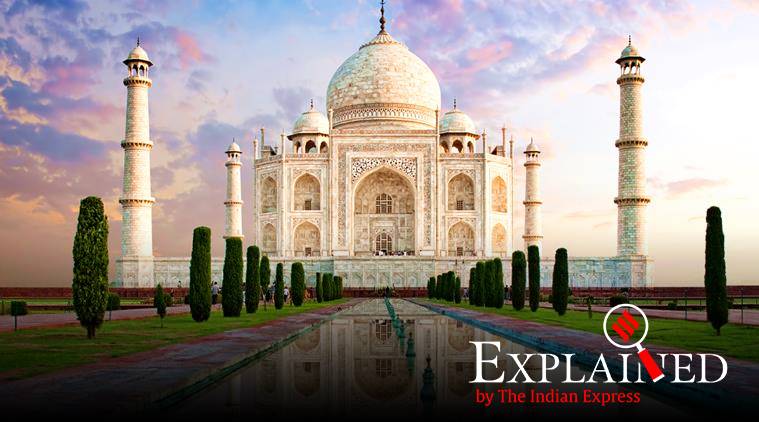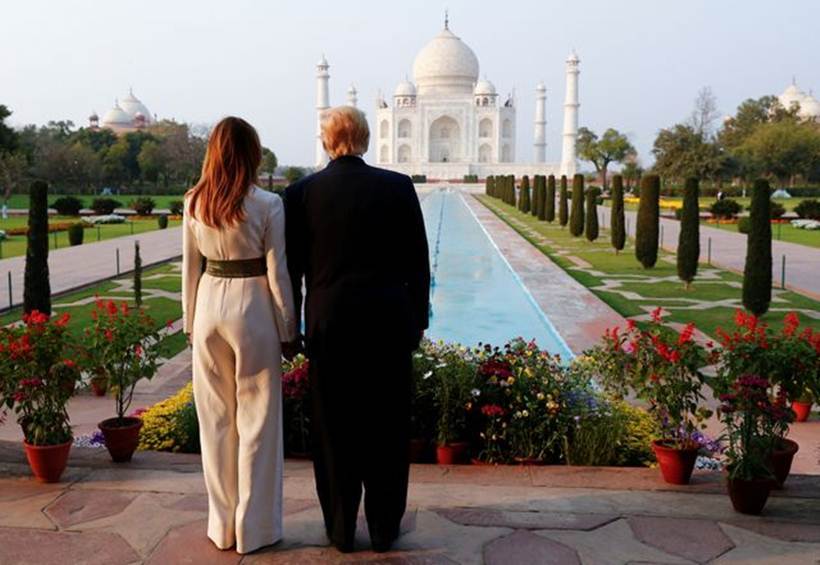- India
- International
Explained: Mud packs and other remedies to save the Taj from pollution, age, and insects
Mud packs were applied on the surface of the monument first in 1994, and then again in 2001, 2008, and, most recently, beginning 2014.
 The Taj Mahal was completed in 1653 as a mausoleum for the Emperor’s favourite wife, Mumtaz Mahal, who died in childbirth.
The Taj Mahal was completed in 1653 as a mausoleum for the Emperor’s favourite wife, Mumtaz Mahal, who died in childbirth.
The Taj Mahal complex has been spruced up for the visit of United States President Donald Trump and First Lady Melania Trump. A PTI report over the weekend said the red sandstone corridors had been cleaned of weather stains, the fountains had been scrubbed, and extra flower beds had been added to the gardens.
Taj Mahal makeover: Mud packs
According to an ASI official quoted by the report, the graves of Emperor Shah Jahan and his queen Mumtaz Mahal had received special “multani mitti’ (Fuller’s clay) mud pack treatment”.
Mud packs have been one of the ASI’s favoured ways to remove the yellow stains that have appeared over the years on the Taj Mahal’s white marble facade. It is hoped that the treatment — traditionally employed to clean marble surfaces — will help restore the natural shine and colour of the monument.
The clay is applied in the form of a thick paste that absorbs the grime, grease and bird droppings on the marble, before being washed off using distilled water. The process is slow and tortuous, but is believed to leave the marble cleaner and shinier.
Mud packs were applied on the surface of the monument first in 1994, and then again in 2001, 2008, and, most recently, beginning 2014. Increasing pollution in the air over the Gangetic Valley affecting the Taj has been a reason for concern for archaeologists and conservationists for long now.

📢 Express Explained is now on Telegram. Click here to join our channel (@ieexplained) and stay updated with the latest
The Taj Mahal was completed in 1653 as a mausoleum for the Emperor’s favourite wife, Mumtaz Mahal, who died in childbirth. Both the Emperor and his wife are buried there. The Taj was declared a Unesco World Heritage site in 1983, and and attracts millions of visitors from India and overseas every year.
Losing colour
In 2018, the Supreme Court, frustrated with the situation at the Taj, said that if the mausoleum was to be saved, the Archaeological Survey of India “will have to be thrown out of the picture”. The court had earlier expressed concern over the marble of the Taj changing colour, and asked how the white marble, which had first become yellowish, was now turning brownish and greenish.
The court was hearing a plea filed by environmentalist M C Mehta, seeking protection for the Taj from pollution. Acting on a similar petition filed by Mehta, the court had in 1996 ordered a slew of measures, including the closure of factories in the vicinity, to protect the monument.
 US President Donald Trump with First Lady Melania at the Taj Mahal in Agra on February 24, 2020. (AP Photo)
US President Donald Trump with First Lady Melania at the Taj Mahal in Agra on February 24, 2020. (AP Photo)
There are various factors that have led to the discoloration of the Taj Mahal.
Firstly, the polluting industries and the vehicular emissions in the Taj Trapezium Zone (TTZ) area are a major source of pollution.
The second reason is that the Yamuna river, which flows behind the Taj, has become highly polluted. There is no aquatic life in it, and has caused insect and algae infestation on the Taj Mahal and other monuments situated on its banks.
Ahead of the Trumps’ visit to Agra, the Uttar Pradesh Irrigation Department released 500 cusecs of water from Bulandshahr into the Yamuna to improve its “environmental condition”, PTI reported last week. One cusec is approximately 28 litres.
Insect attacks
During the hearings in the Supreme Court in 2018, the problem of insects damaging the surface of the Taj was highlighted.
In an interview given to The Indian Express at the time, Mehta had said: “The source of this problem comes from the dry river Yamuna, which has become devoid of any ecological flow. These insects, as has been stated in the Archaeological Survey of India’s report, breed in the polluted matter in the river, and then attack the Taj Mahal in the evening.
“Earlier, there were fish in the river, which ate the insects and their larvae, but now, due to the serious water pollution, there is no sign of any aquatic species in the river.”
Mehta recalled that the ASI’s ‘A Report on Insect Activities at Taj Mahal And Other Monuments of Agra’, had noted that green and black patches had developed on the marble facade due to the presence of a specific type of insects, mainly on the northern side of the Taj Mahal.
Don’t miss from Explained: Why is the Taj Mahal losing its colour?
Other monuments that stand on the banks of the river Yamuna, such as the Tomb of Itimad-ud-Daulah, the Mehtab Bagh, and portions of the Agra Fort, too, have been affected by these insect attacks, Mehta had said.
More Explained
Must Read
EXPRESS OPINION
Apr 23: Latest News
- 01
- 02
- 03
- 04
- 05








































